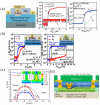Progress in Gallium Oxide Field-Effect Transistors for High-Power and RF Applications
- PMID: 38138834
- PMCID: PMC10744974
- DOI: 10.3390/ma16247693
Progress in Gallium Oxide Field-Effect Transistors for High-Power and RF Applications
Abstract
Power electronics are becoming increasingly more important, as electrical energy constitutes 40% of the total primary energy usage in the USA and is expected to grow rapidly with the emergence of electric vehicles, renewable energy generation, and energy storage. New materials that are better suited for high-power applications are needed as the Si material limit is reached. Beta-phase gallium oxide (β-Ga2O3) is a promising ultra-wide-bandgap (UWBG) semiconductor for high-power and RF electronics due to its bandgap of 4.9 eV, large theoretical breakdown electric field of 8 MV cm-1, and Baliga figure of merit of 3300, 3-10 times larger than that of SiC and GaN. Moreover, β-Ga2O3 is the only WBG material that can be grown from melt, making large, high-quality, dopable substrates at low costs feasible. Significant efforts in the high-quality epitaxial growth of β-Ga2O3 and β-(AlxGa1-x)2O3 heterostructures has led to high-performance devices for high-power and RF applications. In this report, we provide a comprehensive summary of the progress in β-Ga2O3 field-effect transistors (FETs) including a variety of transistor designs, channel materials, ohmic contact formations and improvements, gate dielectrics, and fabrication processes. Additionally, novel structures proposed through simulations and not yet realized in β-Ga2O3 are presented. Main issues such as defect characterization methods and relevant material preparation, thermal studies and management, and the lack of p-type doping with investigated alternatives are also discussed. Finally, major strategies and outlooks for commercial use will be outlined.
Keywords: RF; defects; field-effect transistors (FETs); gallium oxide; high power; wide-bandgap semiconductor.
Conflict of interest statement
The authors declare no conflict of interest. The funders had no role in the design of the study; in the collection, analyses, or interpretation of data; in the writing of the manuscript, or in the decision to publish the results.
Figures






















References
-
- Technavio Wide-Bandgap (WBG) Power Semiconductor Devices Market Analysis 2026. [(accessed on 15 October 2023)]. Available online: https://www.technavio.com/report/wide-bandgap-wbg-power-semiconductor-de....
-
- Reese S.B., Remo T., Green J., Zakutayev A. How Much Will Gallium Oxide Power Electronics Cost? Joule. 2019;3:903–907. doi: 10.1016/j.joule.2019.01.011. - DOI
-
- Millan J., Godignon P., Perpina X., Perez-Tomas A., Rebollo J. A Survey of Wide Bandgap Power Semiconductor Devices. IEEE Trans. Power Electron. 2014;29:2155–2163. doi: 10.1109/TPEL.2013.2268900. - DOI
-
- Chow T., Tyagi R. Wide bandgap compound semiconductors for superior high-voltage unipolar power devices. IEEE Trans. Electron Devices. 1994;41:1481–1483. doi: 10.1109/16.297751. - DOI
-
- Pearton S.J., Ren F., Tadjer M., Kim J. Perspective: Ga2O3 for ultra-high power rectifiers and MOSFETS. J. Appl. Phys. 2018;124:220901. doi: 10.1063/1.5062841. - DOI
Publication types
Grants and funding
LinkOut - more resources
Full Text Sources

